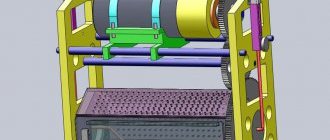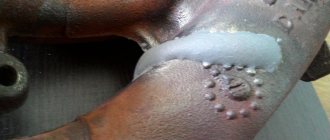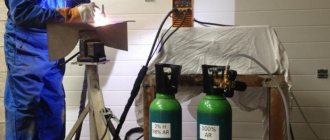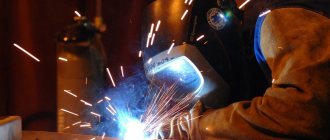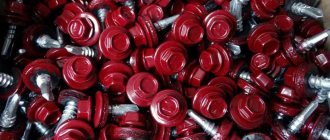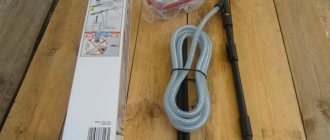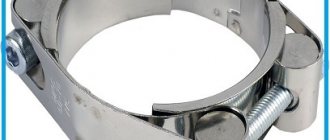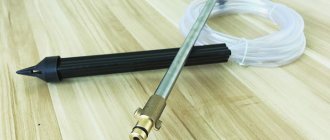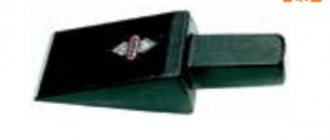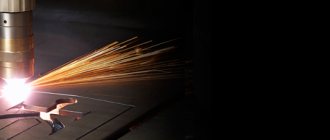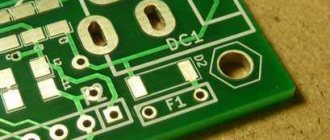Cleaning in an ultrasonic bath
Today, cleaning surfaces using ultrasonic baths has become commonplace. Ultrasonic baths are used in almost all types of industry, but are most popular in jewelry, electronics repair, cleaning personal care items, and auto repair shops.
However, buying a cleaning device is one thing, but finding a specialized liquid for an ultrasonic bath is quite a difficult task. As a rule, in cases where it is impossible to buy a special liquid, it is made independently.
Before you go buy liquid for ultrasonic baths , you need to clearly define the scope of use. Why? Because one type of liquid is suitable for cleaning one material, but when used in another profile it will not show results.
That is why you need to carefully select the area of use when purchasing a cleaning fluid. Below are examples of how you can prepare the liquid manually. The main thing to understand is that the basis of any cleaning liquids is a simple composition. Typically this is water or alcohol. And when creating a solution, you need to choose what base you will use.
Alcohol is used in cases where it is necessary to wash the circuit boards of mobile phones or other electronic equipment. Alcohol allows you to avoid creating short circuits between parts on the board (transistors, resistors, chips, etc.).
As you know, alcohol is a dielectric. Moreover, the use of alcohol will be justified in cases where it is necessary to clean the surface of compounds that exhibit hydrophilic properties (resistant to water).
Water is used when cleaning more delicate materials such as jewelry. In addition, water itself is already a good cleaner, although it does not show such good results as when combined with a surfactant. Surfactants, or surfactants, are used in combination with water.
The simplest surfactant is a soap solution. You can use a soap solution when washing fabrics, washing injectors and car parts. In addition, you can use washing powders, car shampoos, and dishwashing detergents. In mass purification, it is recommended to purchase cheaper chemical additives for water in bulk, such as Sulfanol NP, Neonol.
In addition to water and alcohol, there are special cases of using gasoline, kerosene and other similar materials. The specialist needs to be careful when using such liquids for ultrasonic baths , as they ignite quickly.
Can you tell me what homemade detergent is best for cleaning nozzles in an ultrasonic bath?
Do not offer flammable substances.
Rating review
Ultrasound camera CODYSON CD-4820
Suitable for processing any metal tools. Effectively removes residues of manicure products - acrylic, gel, as well as particles of biological material. Ideal for beauty salons and offices with high traffic, as it is equipped with a spacious 2.6 liter capacity.
- Manufacture: China;
- Dimensions: 29*23*18 cm.
Advantages:
- 6 month manufacturer's warranty;
- 5 operating modes;
- digital display.
Ultrasonic cleaner UltraEst-M
The Russian-made ultrasonic bath is designed for treating cosmetic, dental and manicure instruments.
Volume – 1.6 l. Dimensions: 26*18*16 cm.
Advantages:
- the ability to place tools directly on the bottom, without using a tray;
- timer from 1 to 15 minutes.
Flaws:
- small capacity at a high price.
Ultrasonic bath SD – 2000
A compact bathtub with dimensions of 20*13*15 cm with a chamber volume of 0.6 liters is suitable for manicure and pedicure instruments, as well as for household use - for cleaning chains, bracelets and other jewelry.
Manufacture: China
Advantages:
- timer;
- screen;
- 6 month warranty.
The affordable price of the model makes it attractive for small salons or manicure rooms.
Ultrasonic cleaner Elmasonic S10
An ultrasonic washer made in Germany with a working capacity of 0.8 liters is suitable for processing tools made of metal, plastic and glass.
Made from high quality stainless steel. External dimensions: 20*15*13 cm.
Advantages:
- automatic degassing mode;
- short-term and endless cleaning modes;
- Overheating fuses with automatic shutdown after 12 hours from start-up.
Flaws:
- high price.
The high price of Elmasonic S10 makes it inaccessible for small offices, so it is recommended for purchase by large beauty and cosmetology salons.
Euronda, Ultrasonic cleaner Eurosonic Energy
The Italian-made device is distinguished by an increased volume - 2.7 liters, as well as the ability to combine 2 different solutions in one cycle using glass glasses included in the kit. This model, of course, cannot be called a budget one, but Italian quality can be seen in every detail of the device - the body, handles, and lid.
Dimensions: 27*24*22 cm
Advantages:
- sound-absorbing cover;
- capacity;
- the ability to combine 2 types of solution in one cycle.
Flaws:
- weight – an empty sink weighs 3.7 kg;
- price - for Italian quality you will have to pay from 30 to 40 thousand.
Despite the high price, the Italian model has mostly positive reviews, lasts a long time and rarely fails. We recommend purchasing Eurosonic Energy to everyone whose budget allows it.
IRISK, Ultrasonic bath
The most budget model from today's selection from the Irisk brand of manicure and pedicure products. It has several programmed modes and a 0.75 liter tank.
- Manufacture: China;
- Dimensions: 16.5*13*6 cm.
Advantages:
- low price;
- compactness;
- timer from 1.5 to 7.5 minutes.
The ultrasonic cleaner from Irisk is suitable for a private technician, as it is small in size and has an affordable price.
Elamed, Ultrasonic washer UZO1-01 Medel
The device is from a Russian manufacturer of medical instruments. The unusually shaped sink is a unit consisting of an ultrasonic emitter in the upper part and a working container in the lower part. Medel is used in medical offices, but is perfect for a cosmetologist's or manicurist's office.
- Volume: 1 l.
- Dimensions: 43*52*50 cm.
Advantages:
- timer from 1 to 10 min. at intervals of 1 minute;
Flaws:
- dimensions and weight - almost 6 kg;
- high price.
Do you use an ultrasonic bath?
Share your experience in the comments! Comment
What is an ultrasonic bath?
High frequency waves can affect materials in aggressive environments. The principle of operation of an ultrasonic bath is to place parts in a special liquid, then the components move under the influence of waves. An increase in pressure leads to the process of cavitation at the molecular level; the resulting bubbles explode during the movement of atoms. You can learn how to use an ultrasonic bath from the product’s operating instructions; pressure is applied to various materials in the required proportions.
An ultrasonic bath consists of a liquid bowl made of stainless metal alloys. For home use or cleaning small products, a bath of up to a liter is used. Industrial production uses large volumes of bowls, which can be used to clean bulky objects. The frequency and range of ultrasonic waves operates in modes from 18 to 120 kHz; sounds at such levels are inaudible to humans. Exposure to ultrasound occurs in various areas, from hospitals to jewelry workshops; if you have certain skills, it is possible to make an ultrasonic bath with your own hands.
Types of pollution
Various application environments make the ultrasonic bath a versatile device. The mechanism has found its main application in car services and industries where it is necessary to remove the following types of contaminants:
- solid deposits that appear during the operation of mechanisms;
- protective film coatings are removed before connection by soldering or inside products that interfere with normal operation;
- oxidation and corrosive deposits.
In a homemade ultrasonic bath, it is possible to wash printed circuit boards and other radio materials. Before use, just immerse the part in liquid and start the process.
Field of application of ultrasonic baths
Many parts are cleaned using ultrasound. The availability of the design makes the use of ultrasonic baths increasingly popular in various industries.
- Jewelers use the bath to clean soot and dirt from old jewelry. Hard-to-reach places can be easily cleaned using a special solution. The method is important because there are no traces of mechanical influences left on the parts, which is especially important when working with antique parts.
- Optical products and all kinds of lenses can be easily cleaned with ultrasound.
- It is used in the electronics industry when processing old circuit boards; it is impossible to clean radio components using mechanical action; there is a possibility of damaging important connections.
- The chemical industry has identified the device as a possible mechanism for accelerating processes through cavitation effects.
- The automotive industry and printing stations use ultrasonic machines to wash mechanisms and components.
The device is also widely used by car repair shops for cleaning carburetors, injectors, and throttle valves. Some mobile device repair service centers use a bath to remove solder build-up from small parts on circuit boards.
Selection rules
Before choosing a bathtub, you should pay attention to many parameters, the main ones of which, if chosen incorrectly, can prevent the work from being completed. Its price and power directly depend on the size of the device. Some modifications are equipped with touch panels for easier control. Cleaning small items does not require an increased volume of the bowl; on the contrary, an increased volume requires a greater consumption of liquid, which cannot be reused.
One of the important criteria is the presence of a heating element that maintains the temperature of the liquid within certain limits. Heating is carried out for a faster process, saving time on cleaning the product. The timer will allow you to set a specific time and notify you when work is completed.
It is necessary to pay attention to the presence of a set of special clamps and baskets that will make it easier to immerse the part in the container.
Ultrasonic bath repair
Regardless of the quality of the device, use in an aggressive environment requires repair. Maintenance and repair of an ultrasonic bath is not available through every service due to the lack of qualified technicians.
Self-repair of the mechanism includes a preliminary visual inspection. A superficial analysis begins with checking the cable for breakdowns, liquid leakage and rattling inside the housing, after which it is necessary to check:
- an electronic board attached to the bottom of the mechanism;
- batteries;
- piezo emitter;
- power switch or timer.
Ultrasound bath diagnostics
Diagnostics of a specific unit can be performed independently; the best option would be to install the failed element on another device. Some instructions describe how to consistently carry out maintenance; it is better to follow the manufacturer's recommendations for safe operation and quick results.
Principle of operation
From the name of this device it becomes clear what underlies its functioning. Ultrasound is a kind of vibration, the frequency of which exceeds 18 kHz. The liquid in such a bath is filled with a large number of bubbles, which burst under the influence of high pressure, creating an effect called cavitation.
The principle of operation is as follows: an object that requires cleaning is immersed inside a reservoir with a solution. After starting the device, the bubbles, bursting, act on the contaminated mechanism and remove plaque from it. This method allows you to get rid of dirt even in the most inaccessible parts of the product without violating its structural integrity.
Cashless payments
Please make payments for equipment only using the following details:
OGRN 5067746767501, Registration date September 21, 2006
Recipient: Limited Liability Company "Technosoyuz" Legal entity. address: 109029, Moscow, Nizhegorodskaya st., 32, building 15 Fact. Address: 143960, Moscow region, Reutov, st. Fabrichnaya, 7, office 310 INN: 7709701457 Checkpoint: 770901001 OGRN: 5067746767501
Option 1: SOKOLOVSKY Bank
Account number 40702810600000000884 in JSC KB Sokolovsky, Moscow Account number 30101810545250000901 BIC 044525901
Option 2: Sberbank of Russia
Account 40702810340040006789 in PJSC SBERBANK OF RUSSIA, Moscow Account 30101810400000000225 BIC 044525225
